Watch Chris Wood, President and CEO of Trout Unlimited, deliver the 2016 State of TU speech at the TU Annual Meeting in Bozeman, MT.
Mick McCorcle, Chair of the National Leadership Council, gives the 2016 State of the Grassroots in Bozeman, Mt.
Watch Chris Wood, President and CEO of Trout Unlimited, deliver the 2016 State of TU speech at the TU Annual Meeting in Bozeman, MT.
Mick McCorcle, Chair of the National Leadership Council, gives the 2016 State of the Grassroots in Bozeman, Mt.
By Randy Scholfield
Take a look at this picture. Yes, there is hope for the Animas River.
You remember the Gold King mine spill from last August, which dumped 3 million gallons of toxic heavy metal sludge into the upper Animas and sent a yellow-orange plume sweeping downstream through Durango and on into New Mexico.
Amazingly, the spill didn’t seem to immediately impact the Gold Medal trout population through Durango. And a recent survey of the fish population confirmed that they’re doing well. Again, that picture, taken during the survey, speaks volumes.
But the fact remains that the Animas—and many other rivers and streams across the West—remain impaired by day-in, day-out toxic mine seepage. On the Animas watershed, the discharge amounts to a Gold King spill every few days. You can’t see it, but it’s there—and has been for decades.
That’s why the upper few miles of the Animas, below Silverton to about Cascade Creek, are largely barren of fish and aquatic life.
A couple weeks ago, I met my colleague Ty Churchwell for a tour of the new Superfund sites in San Juan County, including the Gladstone area, home of the Gold King Mine. It was eye-opening.
The abandoned mine complex surrounding the town of Silverton is extensive and daunting. Amid the spectacular fall colors and scenery, the mountains are pockmarked with leaking adits, tunnels and waste piles. For years, Churchwell told me, the Animas River Stakeholders Group has worked to identify and characterize each site – what’s the chemistry of the discharge, is the site public, private or abandoned?
The ARSG identified roughly 60 trouble sites, a mixture of point- and nonpoint-source (the former could be a leaking mine opening, or adit, the latter is more dispersed runoff, such as from a waste pile). And they set out to address some of the sites they could legally clean up (the non-point source sites).
Of those 60 sites, four are particularly bad and make up the lion’s share of pollutants entering the Animas watershed. These four mines alone contribute some 800-1,000 gallons per minute. That’s about 1 million gallons of toxic water flowing every 3 days out of these tunnels—the equivalent of a Gold King spill.
The EPA, in creating the Bonita Peak Mining District Superfund site, included 47 sites that together discharge about 5.4 million gallons a day into the Animas. That amounts to almost 2 Gold King spills every single day.
“The trout are the canary in the coal mine—they’re an indicator species,” says Churchwell. “We’re trying to bring back water quality in the Silverton area that will support a healthy ecosystem—that, in turn, will support a variety of uses, from recreation and agriculture to community water supply.”
Silverton is beginning to recognize the economic opportunity of a healthier river—cleaner water quality could lead to expanded opportunities for fly-fishing and tubing. And the Superfund remediation work itself could put many locals to work cleaning up mines.
Under the Superfund plan, the present temporary water treatment plant below the Gold King mine will eventually be replaced by a permanent water treatment plant that will tap the runoff of the four worst mines (all within a half-mile of each other) and pipe it to the treatment plant, where it will be brought up to standards and then discharged back into Cement Creek.
Good Samaritan legislation also remains a top priority for Trout Unlimited. Put simply, Good Sam creates a new discharge permit category that makes it easier for qualified Good Sam groups to help clean up abandoned mines. The permits allow for a lower standard for cleanups (30-50 percent, say, not 95 percent as under current Clean Water Act regulations) and there’s a sunset clause that doesn’t hold Good Sam groups responsible for cleanup costs in perpetuity– that’s been a financial dealbreaker for most groups.
The Bandora mine, which we reach on a rocky, bumpy four-wheel-drive road, is a great candidate for Good Sam, says Churchwell. We park and huff up to an old wooden mine structure, with orange runoff leaching down the hillside into South Mineral Creek, which eventually flows into the Animas.
Pointing to a broad valley below us, Churchwell says it’s a good place for a “bioreactor”—basically, a created marsh area that will naturally filter and clean the water over the long-term.
Taken together, these cleanup approaches could eventually bring the upper Animas below Silverton to a level of water quality that will support a healthy trout fishery. It probably won’t ever match the Gold Medal waters through Durango, but it could be a local source of pride and offer several miles of quality fishing.
Take another look at that trout picture. The Animas is worth fighting for—and TU is in it for the long haul.
Go to the We Are the Animas website to learn more about TU's efforts to clean up this great Western river.
Randy Scholfield is TU’s communications director for the Southwest region.
Where: Jefferson County Fairgrounds - Golden, CO
When: November 5th - 6th; 8:30am - 5:00pm
Cost: $8 in Advance, $10 at the door
Website: www.flyfishingrendezvous.com
If you want to start thinking like a fish and fishing like a pro, the Fly Fishing Rendezvous happening November 5th - 6th at the Jefferson County Fairgrounds in Golden Colorado is a must visit event! There will be more than 30 hours of classes and clinics from the region's best instructors, authors and fly tyers, including Pat Dorsey, Robert Younghanz, Duane Redford, and Rick Tackahashi.
You can check out the full vendor and class line-up and purchase your tickets online at: www.flyfishingrendezvous.com.
The Fly Fishing Rendezvous has partnered with Colorado Trout Unlimited and Project Healing Waters to highlight and support the vital work they are doing in conservation and support of our country's veterans. In addition to raffles and silent auctions held at the event that support both of these groups, 10% of the admission fees go to support Colorado Trout Unlimited, and we encourage every angler to join TU and Project Healing Waters on mission in the conservation of our waters and support of the troops. Tickets are $8 in advance and $10 at the door.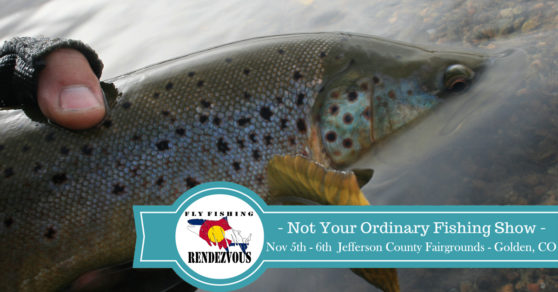
As much as any of us would love to have a stretch of river all to ourselves, an isolated fishing hole where big trout eagerly rise to our dry flies, and the lack of cell phone reception gives us a few hours respite from the demands of life, fly fishing at its core is a social sport. For most of us, it was under the guiding hand of a parent, grandfather, or friend that we tied on our first fly, struggled through the basics of casting, and eventually netted our first trout. There is a unique joy in sharing the water with family and friends, seeing the passion for fly fishing awaken in a new angler, and the excitement of working out a difficult drift with your fishing buddies until one of you finally catch that elusive trophy brown that has evaded you the past several hours.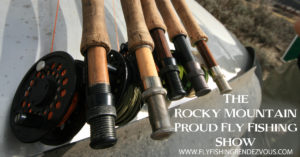
Born from a passion to make the sport of fly fishing accessible to all, and to equip Rocky Mountain anglers with the knowledge and gear needed to experience greater success on the water, the Fly Fishing Rendezvous has become the fastest growing and most eagerly anticipated fly fishing show in the Rockies. Featuring only the region's best fly fishing companies, fly tyers, authors, and guides, the Fly Fishing Rendezvous focuses exclusively on local waters and local companies, and equips anglers with local knowledge for success on our waters. With its emphasis on educating anglers, the Fly Fishing Rendezvous has broken the mold of other fly fishing shows by giving participants access to more than 30 hours of classes with fly fishing's best recognized authors, fly tyers, casting instructors, and fly fishing geeks. The topics of these classes are as diverse as the waters of our region: How to Fish Colorado's Technical Tailwaters, How to Match the Hatch and Hack Hatch Charts, How to Sight Fish Trophy Trout on the Taylor River, as well as fly tying demonstrations with the industry’s best tyers. In addition to accessing an impressive line-up of classes, participants of the rendezvous will have the ability to interact with and buy gear or trips from more than 30 Rocky Mountain fly fishing companies. Whether it’s a new fly reel from Ross, waders from Simms, $10 dozens on flies from Ascent Fly Fishing, or a guided trip on private water, there will be something for every fly fisher at this show!
Article by: Phil Lindeman of Summit Daily posted on 10/18/2016
Most folks would quit a puzzle with no solution. Then again, Kristina Dougherty isn’t your average puzzlemaster.
“I’ve always looked at the river like a giant puzzle,” said Dougherty, a guide with Anglers Covey in Colorado Springs and member of Gore Range Anglers, the Summit County chapter of nonprofit Trout Unlimited. “When you can crack that code — when you find the right combination of flys and small adjustments to get a fish — it’s the best. I love the fact you can never learn it all.”
On Oct. 20 (as in tomorrow), Dougherty and another female guide, Summit resident Sarah Barclay of Blue Quill Angler in Evergreen, bring their love of fly-fishing, rivers and all the associated puzzles to the monthly meeting of Gore Range Anglers. The topic for the month: how female guides across the state and nation are breaking into a sport that’s traditionally been dominated by dudes. Officials with Gore Range Anglers asked Dougherty and Barclay to talk about their wildly different experiences with fly-fishing, but it’s still no surprise that the two share a passion for the small and sometimes frustrating aspects of the sport.
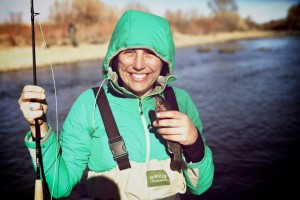 “It’s the consummate riddle that’s never solved, when you’re on the river and fishing,” said Barclay, a real estate agent with Slifer, Smith and Frampton who’s been moonlighting as a guide with Blue Quill Angler for more than a decade. “And it takes you to beautiful places. Just don’t wait for it to show up on your bucket list — get out there now.”
“It’s the consummate riddle that’s never solved, when you’re on the river and fishing,” said Barclay, a real estate agent with Slifer, Smith and Frampton who’s been moonlighting as a guide with Blue Quill Angler for more than a decade. “And it takes you to beautiful places. Just don’t wait for it to show up on your bucket list — get out there now.”
That’s exactly what Barclay did 12 years ago, when her boyfriend bought her waders and boots for Christmas. It became the best Christmas gift she ever received, she said, and she soon fell head over heels for everything angling: the flys, the technique, the water, the serenity.
Along with her angling career — she’s been a guide for more than a decade and regularly works with at-risk youth — Barclay also plans to talk about one of her favorite locations: the Bighorn River in Montana, a tributary of the Yellowstone River. She discovered it not long after discovering the sport, and today she considers it her home river.
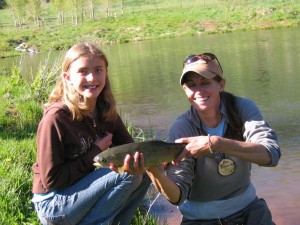 “A guide friend told me: ‘Have a river that you fish and know intimately, all times of the year and in all conditions,’” said Barclay, who travels north to the Bighorn at least four times per year. “So I followed what he said, and now I fish it in winter and summer, all year long, from low flows to high flows.”
“A guide friend told me: ‘Have a river that you fish and know intimately, all times of the year and in all conditions,’” said Barclay, who travels north to the Bighorn at least four times per year. “So I followed what he said, and now I fish it in winter and summer, all year long, from low flows to high flows.”
Dougherty’s introduction to the angling puzzle came about 15 years ago, when she was fresh out of high school and learned to fish with her dad.
“A lot of people learn from their dads, but we went through the process together,” Dougherty said. “We had a lot of laughs that way. I’ve always been kind of a daddy’s girl, so if he was going to do it I wanted to be there too. He didn’t realize he created a monster. The addiction took root right away.”
In March, Dougherty turned her addiction into a full-time guiding gig with Anglers Covey, which boasts six female guides. She regularly fishes the South Platte and Arkansas rivers and joins trips across the region with a female-friendly group, Pikes Peak Women Anglers, with nearly 30 members in Colorado Springs. She also leads mother-daughter trips, like an excursion last week when one of the novice mothers caught three fish in 30 minutes. She must have heeded Dougherty’s advice: “Don’t overthink it.”
“By experience, women pick up the sport faster than men,” Dougherty said. “They use more finesse, they pick up on casting quicker, and all of that is important when you’re starting. Just try to learn as much as possible in your own time.”
Barclay’s advice for ladies? Follow her example and give it a go.
“There are so many people who would love to teach you and help you,” Barclay said. “We are blessed in our county to have over six fly-fishing shops, these star-studded rivers, and it’s a really fun demographic to be a part of. Everyone is fired up to help everyone else.”
A lot of the on-the-ground conservation work done by Trout Unlimited and its chapters involve planting willows or other stream-side vegetation to help the river. But how do plants on the land exactly affect the stream?
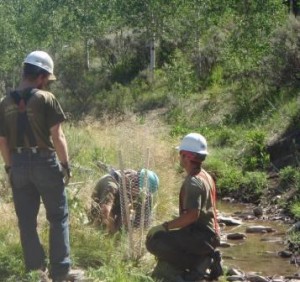
Most of the vegetation work done by TU projects involve planting Willow Trees. The reason behind the Willow is that they are a durable plant for fluctuations in their surrounding environment. Willows are able to absorb chemicals that may hurt the water quality, stabilize soil, and grow in saturated areas.
Planting Willows is a big part of the Fraser Flats Habitat project as the willows and other native plants improve bank stability and provide cooling shade along this open meadow stretch of the Fraser River. The shade allows for trout to seek cooler water when flows are lower or air temperature is higher.
Willows are not the only plant commonly used on river banks to help stream quality, the best plants are the native plants. And on the contrary, invasive plants could be the worst. Russian Olives have been being removed by TU and other partners along the stream due to the negative effects they cause.
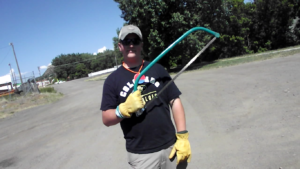 At the Colorado TU Youth Camp, campers helped remove Russian Olive Trees from the the banks of the Purgatoire River. Russian Olives deplete the water resource by consuming large amounts of water while also limiting human and animal use of the waterway.
At the Colorado TU Youth Camp, campers helped remove Russian Olive Trees from the the banks of the Purgatoire River. Russian Olives deplete the water resource by consuming large amounts of water while also limiting human and animal use of the waterway.
Native plants work best on streams for obvious reasons as they have been adapted to the environment around them. Plants that don't use a lot of water, but offer shade to the trout and micro-invertebrates allow streams to remain healthy. A lot of native plants are also able to withstand higher flow rates and don't break off into the stream in case of a flood.
Plants are also available to provide a food source for species in the aqautic ecosystem, (as well as the the entire ecosystem). Especially the micro-invertebrates that trout rely on. These bugs find their food source in the riparian zone- the area between the upland zone (the area of the watershed that does not receive regular flooding by a stream) to the aquatic zone, the area of the stream channel covered by water, controlling the flow of water, sediment, nutrients, and organisms between the two.
Grand County residents have been at the forefront of water issues in the West. They were the water supplier of the first major trans-mountain diversion project in Colorado and since then have been supplying water to Front Range municipalities. These diversions have also led Grand County residents and Trout Unlimited to be at the forefront of a new initiative- Learning by Doing. Learning By Doing (LBD) is a collaborative group of water stakeholders — including water utilities, nonprofit organizations and county agencies — that meet regularly to monitor river health and undertake projects that safeguard Grand County’s home waters.
LBD has already solved some issues including sending additional flows in Ranch Creek, Vasquez Creek and the Fraser River to benefit aquatic life. Full operation of LBD is expected to start in 2018 when approximately $2 million and 1,000 acre-feet of water will be dedicated to the cooperative effort after final permits are obtained.
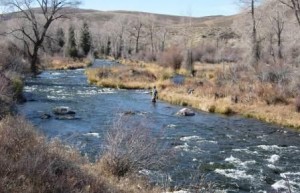
Although full operation hasn't begun, the pilot program of LBD was launched this fall as the Fraser Flats Habitat Project. The project plans to improve a degraded 0.9-mile reach of the Fraser River just south of County Road 83. The project builds on restoration of the river upstream on the North 40 and in the Town of Fraser. Fraser Flats will extend improvements to fish habitat on the river.
Fraser Flats combines adjoining public and private sections to maximize efficiencies in costs and to set the stage for future public-private partnerships that benefit river health. County Road 83 will also open for public access and fishing when the project is completed.
The total cost for the project is $200,000 and is funded by a combination of funds committed by LBD cooperative efforts from Grand County, LBD partner contributions, a private landowner, and a Fishing Is Fun grant from Colorado Parks and Wildlife.
Design and permitting is currently underway and revegetation of the reach will begin in the Spring of 2017. In fall 2017, construction in the river will take place. That work will concentrate flows into a narrower channel and provide a series of riffles and pools to enhance fish habitat.
If you're interested in helping volunteer to plant willows, you can sign up here.
Registration is now open for Colorado Trout Unlimited's Fall Board and Leadership Meeting. This meeting is a great opportunity for you to network with other TU leaders in the state and learn about what projects are currently happening. There will also be a tour of Hermosa Creek where participants will get a first hand look into a collaborative conservation project. This meeting will be held in Durango, CO the weekend of October 22-23.
Click on the registration link to find the agenda and learn more about the details of the weekend.
https://org2.salsalabs.com/o/7023/p/salsa/event/common/public/?event_KEY=84398
Two recent Durango Herald Articles talk about the improvements of the Animas and the future of Hermosa Creek. Trout Unlimited has been on the forefront on both of these positive subjects. The Animas River has shown signs of improvement as the fish population is providing "encouraging" signs. As the Animas continues to face adversity and hardship from acid mine drainage, low water flows, urban runoff, and higher temperature, Colorado Parks and Wildlife biologists have seen encouraging signs.
 Over the last decade population studies on the Animas have shown a decline. Although this year there wasn't a turn around, CPW Biologist Jim White told the Durango Herald, "It's been a really nice fish year. It’s definitely been more abundant than years past.”
Over the last decade population studies on the Animas have shown a decline. Although this year there wasn't a turn around, CPW Biologist Jim White told the Durango Herald, "It's been a really nice fish year. It’s definitely been more abundant than years past.”
The study showed more young brown trout were able to survive over winter. Rainbow trout also had plentiful numbers meaning the survival rate was rising. The amount of quality trout- 14 inches or higher- doubled from last year's study.
“There is promising news about the current condition of the fishery, even in this first summer after the ‘spill,” said Ty Churchwell, Trout Unlimited Backcountry Coordinator. “With that said, none of this should diminish the fact that we have a major problem in the top of the watershed with draining mines and poor water quality. The Animas gorge below Silverton remains a ‘dead’ stretch of river, and we have lots of work to do to make this watershed healthy as a whole.”
 While the Animas is improving, the future of Cutthroat Trout in Hermosa Creek also have a bright future as stream improvements have been made to prepare for Colorado River Cutthroat reintroduction.
While the Animas is improving, the future of Cutthroat Trout in Hermosa Creek also have a bright future as stream improvements have been made to prepare for Colorado River Cutthroat reintroduction.
Vegetation was planted and spawning areas were made along the stream to sustain a healthy future Cutthroat population.
At the October Board Meeting, participants will be able to take a tour of Hermosa Creek. The tour will focus on sites with the native trout project and visit some habitat improvements, tour participants will walk away with a better understanding of what it takes to work together and pull off a truly comprehensive conservation program.
Written by: Heather Sees, president of the GreenbacksPhotos by: Emma Brown
Colorado TU, with help from The Greenbacks of Trout Unlimited, strive to educate, connect with, and influence the next generation to become conservation stewards and active participants in the fly fishing community. We recently had the opportunity to partner with a new camp, Forward Rising to accomplish just this.
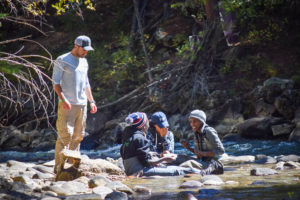 Forward Rising Inc, the creator of Forward Rising camp, is a new organization that focuses on engaging inner city girls through conservation, fishing, and the great outdoors. The organization hopes to use these activities to offer the girls outlets to the challenges they face.
Forward Rising Inc, the creator of Forward Rising camp, is a new organization that focuses on engaging inner city girls through conservation, fishing, and the great outdoors. The organization hopes to use these activities to offer the girls outlets to the challenges they face.
The weekend kicked off when the Girls, Inc. of Metro Denver van arrived at Lynwood Park in Bailey, CO with six young ladies who were eager, yet a bit hesitant, for the jam packed weekend! As the young ladies got off the van there was a bit of a buzz about what the weekend had in store for them. We kicked off the weekend Friday evening by having a team building exercise where the girls worked together to set up their tents and sleeping bags. After “home” was established the girls were introduced to the amazing team of volunteers and we all participated in ice-breaker games to get to know each other a bit better.
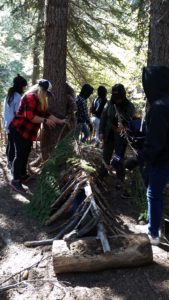 Saturday morning started out pretty chilly so everyone was moving a bit slower, but you could sense the excitement in the air! We kicked off our day with a session on wilderness survival from Mary Margaret Sweeney, PhD – Director at Way of the Wild. Mary spoke about the basics of wilderness survival, emergency shelter construction (with participation and help from the girls) and instruction on how to build a one minute fire. Overall, the young ladies walked away with knowledge on what to do in an emergency if they find themselves in that situation. Following the wilderness survival presentation, we had the pleasure of having Luke Caudillo, UFC fighter, speak to the group about overcoming challenges and following your dreams.
Saturday morning started out pretty chilly so everyone was moving a bit slower, but you could sense the excitement in the air! We kicked off our day with a session on wilderness survival from Mary Margaret Sweeney, PhD – Director at Way of the Wild. Mary spoke about the basics of wilderness survival, emergency shelter construction (with participation and help from the girls) and instruction on how to build a one minute fire. Overall, the young ladies walked away with knowledge on what to do in an emergency if they find themselves in that situation. Following the wilderness survival presentation, we had the pleasure of having Luke Caudillo, UFC fighter, speak to the group about overcoming challenges and following your dreams.
After a short lunch break we kicked off the rest of the afternoon focused on entomology, fly tying and fly fishing. 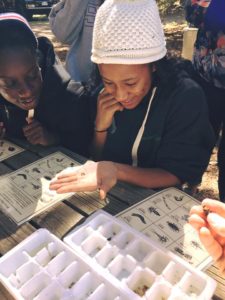 The girls suited up in waders and boots and headed to North Fork of the South Platte River to search for bugs. After turning over rocks and doing the “San Juan shuffle” in front of the bug seines we came away with a few bugs that would later be identified as mayflies, small craw-fish and a couple worms. After a lesson in entomology and discussions around the importance of healthy rivers we tied up some San Juan worms in hopes of tricking the fish!
The girls suited up in waders and boots and headed to North Fork of the South Platte River to search for bugs. After turning over rocks and doing the “San Juan shuffle” in front of the bug seines we came away with a few bugs that would later be identified as mayflies, small craw-fish and a couple worms. After a lesson in entomology and discussions around the importance of healthy rivers we tied up some San Juan worms in hopes of tricking the fish!
The time had come – rods were rigged up, safety and catch and release practices were discussed and each young lady was paired up with a volunteer to try their hand at fly fishing. Shortly after we hit the pond there were screams of excitement – missed fish! After switching up bugs we heard the words that any angler wants to hear “FISH ON!” For the next couple hours we saw several fish to the net – some girls got it on their own, some with a little help, but the end result was the same. After a few hours of catching fish we had a quick dinner and ended the night with a campfire, s’mores, stargazing, a quick visit from Fraser the Fish and reflection on the past couple days!
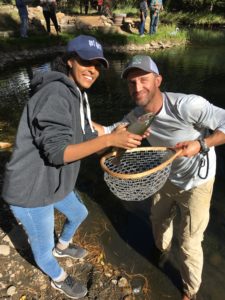 Sunday morning came faster than we expected and the weekend was coming to an end. The weekend contained many firsts – 1st time being in the river, 1st time putting up a tent and sleeping outside, 1st time catching a fish, 1st time making s’mores, 1st time seeing the stars and for some, 1st time being out of Denver. As we cleaned up camp and packed up the van there was still a lot of excitement about the weekend!
Sunday morning came faster than we expected and the weekend was coming to an end. The weekend contained many firsts – 1st time being in the river, 1st time putting up a tent and sleeping outside, 1st time catching a fish, 1st time making s’mores, 1st time seeing the stars and for some, 1st time being out of Denver. As we cleaned up camp and packed up the van there was still a lot of excitement about the weekend!
The 1st annual Forward Rising camp was a huge success, a GREAT time was had by all and we had the opportunity to share our passion and knowledge with the next generation!
A special thanks goes to the sponsors of the camp: Bass Pro Shops, Colorado Parks & Wildlife, SaraBella Fishing, Urban Anglers, Pig Farm Ink. The camp couldn't have been done without their generous support and donations to CTU, The Greenbacks, Forward Rising, and Girls Inc of Metro Denver.
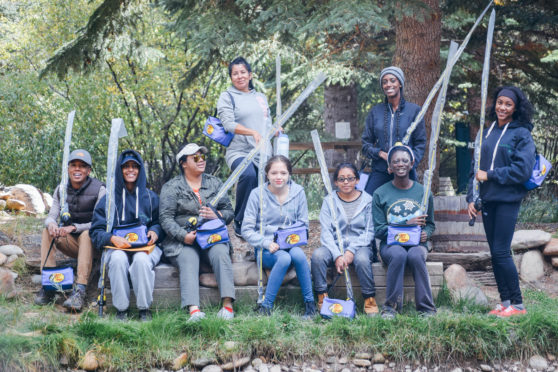
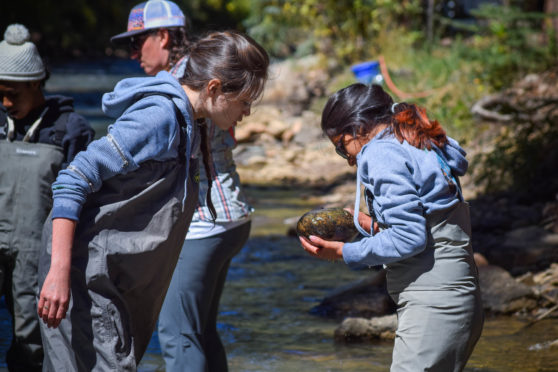
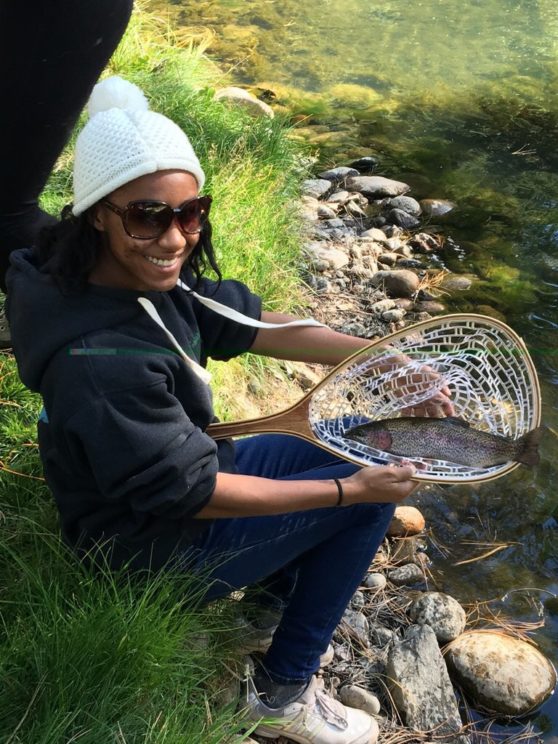
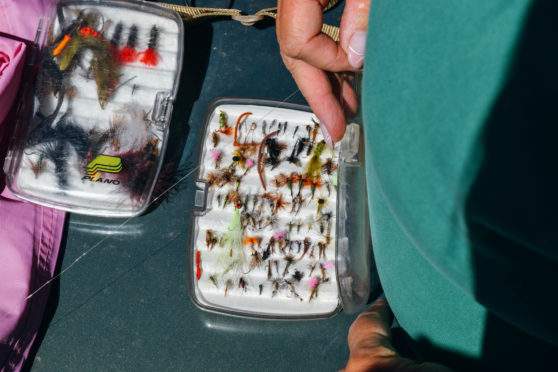
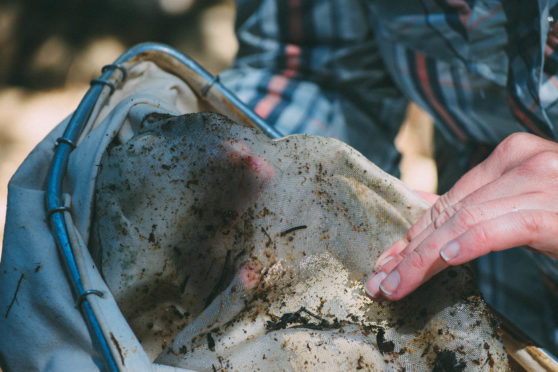
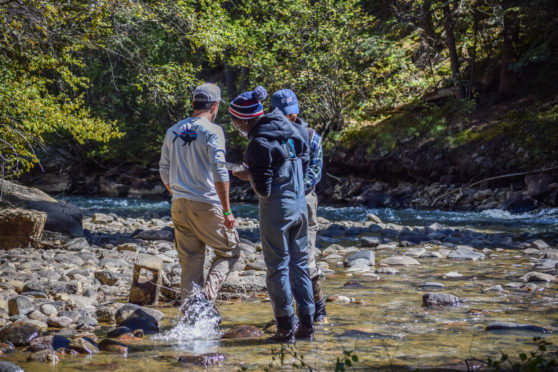
How long have you been a TU member?
Five years, but I have been fly fishing for 47 years.
Why did you become a member and what chapter are you involved with?
I became a member to find some fishing partners and to improve my fishing skills. I stay a member to help give back in some small way. I am currently on the board of the Cutthroat Chapter, but I like to hang out with the Cherry Creek Angler folks as well.
What made you want to become involved with TU?
I had heard about the good work that TU does, and I knew we had local chapters, so it seemed a logical choice.
What is your favorite activity or project that you have done with TU?
 Our chapter's ongoing conservation work on the South Platte River near Deckers strikes a chord with me. One of my earliest memories of being outdoors with my Dad is when he would take me there with his buddy and I would play in the shallows at the edge of the river. Later my good fishing buddy/college roommate and I spent many a pleasant weekend camping there and fishing those waters. Later on I had a great dog, a lab mix, and he would love to go along. We would do our best to keep him out of the water to avoid scaring fish, but he always managed to come home soaked, muddy, and contented. My buddy is busy with family now, and both my father and the dog have passed on. When the Hayman Fire roared through the area it broke my heart. Now the river is recovering with the help of our efforts, those of CUSP, and others. I am honoring the memories of those times I have spent on that river when I do my share to preserve its health and beauty.
Our chapter's ongoing conservation work on the South Platte River near Deckers strikes a chord with me. One of my earliest memories of being outdoors with my Dad is when he would take me there with his buddy and I would play in the shallows at the edge of the river. Later my good fishing buddy/college roommate and I spent many a pleasant weekend camping there and fishing those waters. Later on I had a great dog, a lab mix, and he would love to go along. We would do our best to keep him out of the water to avoid scaring fish, but he always managed to come home soaked, muddy, and contented. My buddy is busy with family now, and both my father and the dog have passed on. When the Hayman Fire roared through the area it broke my heart. Now the river is recovering with the help of our efforts, those of CUSP, and others. I am honoring the memories of those times I have spent on that river when I do my share to preserve its health and beauty.
I know you won’t tell me your top spot, so what is your second favorite fishing spot or favorite fishing story?
I once caught a fish on six flies. On winter day I was fishing the tailwaters of Pueblo Reservoir on the Arkansas River with a three fly rig. Pink San Juan worm, Soft Hackle, and midge. The indicator twitched, I set, and the fight was on. The fish never rose and never jumped, so I figured it was a brown. When it got closer it flashed golden, but an odd sort of gold. So then I wasn't sure it was a brown. When it got really close I saw scales the size of quarters. It was a carp. When I finally got the in the net after a fine fight I reached down to remove the fly and saw he was hooked on the midge, but not the midge I had tied on. With my forceps I removed the midge and lifted the rig up. There was the second fly, but it wasn't my Soft Hackle. I lifted further up and there was a tan San Juan worm, not the color worm that I had tied on. It was a whole separate three fly rig. Latched onto the tan worm was my midge, followed by my Soft Hackle, my SJ worm, and my leader. Apparently this carp had been hooked on someone else's three fly rig and had broken that rig off at the leader, only to be trailing the rig around until my rig snagged that rig. It took six flies for me to catch that carp! I'm sure he was relieved not to be towing that old rig any more as I released him and he swam away.
What does being a part of TU mean to you?
It means learning more about a sport I love, meeting new people with similar passion, and giving back to that sport and to our environment.
What else do you do in your spare time or for work?
I am a retired high school science teacher and I tutor science for Aurora Community College students. I am also a gear head. I am restoring a 1956 Chevy and I substitute teach in the Auto Collision Program at Emily Griffith Technical College. I am also a cyclist, and I love to ride my Trek around town as well as in our beautiful Colorado mountains.